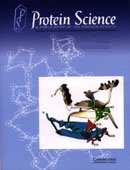Crossref Citations
This article has been cited by the following publications. This list is generated based on data provided by
Crossref.
Schallreuter, Karin U.
Moore, Jeremy
Wood, John M.
Beazley, Wayne D.
Gaze, David C.
Tobin, Desmond J.
Marshall, Harriet S.
Panske, Angela
Panzig, Eberhard
and
Hibberts, Nigel A.
1999.
In Vivo and In Vitro Evidence for Hydrogen Peroxide (H2O2) Accumulation in the Epidermis of Patients with Vitiligo and its Successful Removal by a UVB-Activated Pseudocatalase.
Journal of Investigative Dermatology Symposium Proceedings,
Vol. 4,
Issue. 1,
p.
91.
Marin, Maria C
and
Kaelin, William G
2000.
p63 and p73: old members of a new family.
Biochimica et Biophysica Acta (BBA) - Reviews on Cancer,
Vol. 1470,
Issue. 3,
p.
M93.
Brodsky, Michael H
Nordstrom, William
Tsang, Garson
Kwan, Elaine
Rubin, Gerald M
and
Abrams, John M
2000.
Drosophila p53 Binds a Damage Response Element at the reaper Locus.
Cell,
Vol. 101,
Issue. 1,
p.
103.
Quade, Bradley J.
Yang, Annie
Wang, Yunmei
Sun, Deqin
Park, Jeong-ja
Sheets, Ellen E.
Cviko, Aida
Federschneider, Jerome M.
Peters, Roxana
McKeon, Frank D.
and
Crum, Christopher P.
2001.
Expression of the p53 Homologue p63 in Early Cervical Neoplasia.
Gynecologic Oncology,
Vol. 80,
Issue. 1,
p.
24.
Dohlman, Henrik G.
and
Thorner, Jeremy
2001.
Regulation of G Protein–Initiated Signal Transduction in Yeast: Paradigms and Principles.
Annual Review of Biochemistry,
Vol. 70,
Issue. 1,
p.
703.
Zeng, Xiaoya
Lee, Hunjoo
Zhang, Qinghong
and
Lu, Hua
2001.
p300 Does Not Require Its Acetylase Activity to Stimulate p73 Function.
Journal of Biological Chemistry,
Vol. 276,
Issue. 1,
p.
48.
Zeng, X.
Zhu, Y.
and
Lu, H.
2001.
NBP is the p53 homolog p63.
Carcinogenesis,
Vol. 22,
Issue. 2,
p.
215.
Kelley, Melissa L
Winge, Per
Heaney, Jason D
Stephens, Raymond E
Farell, Julianne H
Van Beneden, Rebecca J
Reinisch, Carol L
Lesser, Michael P
and
Walker, Charles W
2001.
Expression of homologues for p53 and p73 in the softshell clam (Mya arenaria), a naturally-occurring model for human cancer.
Oncogene,
Vol. 20,
Issue. 6,
p.
748.
Strano, Sabrina
Rossi, Mario
Fontemaggi, Giulia
Munarriz, Eliana
Soddu, Silvia
Sacchi, Ada
and
Blandino, Giovanni
2001.
From p63 to p53 across p73.
FEBS Letters,
Vol. 490,
Issue. 3,
p.
163.
Kim, Eun-Joo
Park, Jong-Sup
and
Um, Soo-Jong
2002.
Identification and Characterization of HIPK2 Interacting with p73 and Modulating Functions of the p53 Familyin Vivo.
Journal of Biological Chemistry,
Vol. 277,
Issue. 35,
p.
32020.
Ghioni, Pamela
Bolognese, Fabrizio
Duijf, Pascal H. G.
van Bokhoven, Hans
Mantovani, Roberto
and
Guerrini, Luisa
2002.
Complex Transcriptional Effects of p63 Isoforms: Identification of Novel Activation and Repression Domains†.
Molecular and Cellular Biology,
Vol. 22,
Issue. 24,
p.
8659.
Ince, Tan A.
Cviko, Aida P.
Quade, Bradley J.
Yang, Annie
McKeon, Frank D.
Mutter, George L.
and
Crum, Christopher P.
2002.
p63 Coordinates Anogenital Modeling and Epithelial Cell Differentiation in the Developing Female Urogenital Tract.
The American Journal of Pathology,
Vol. 161,
Issue. 4,
p.
1111.
Ramachander, Ranjini
Kim, Chongwoo A.
Phillips, Martin L.
Mackereth, Cameron D.
Thanos, Christopher D.
McIntosh, Lawrence P.
and
Bowie, James U.
2002.
Oligomerization-dependent Association of the SAM Domains from Schizosaccharomyces pombe Byr2 and Ste4.
Journal of Biological Chemistry,
Vol. 277,
Issue. 42,
p.
39585.
Yan, Wei
Rajkovic, Aleksandar
Viveiros, Maria M.
Burns, Kathleen H.
Eppig, John J.
and
Matzuk, Martin M.
2002.
Identification of Gasz, an Evolutionarily Conserved Gene Expressed Exclusively in Germ Cells and Encoding a Protein with Four Ankyrin Repeats, a Sterile-α Motif, and a Basic Leucine Zipper.
Molecular Endocrinology,
Vol. 16,
Issue. 6,
p.
1168.
Djelloul, Siham
Tarunina, Marina
Barnouin, Karin
Mackay, Alan
and
Jat, Parmjit S
2002.
Differential protein expression, DNA binding and interaction with SV40 large tumour antigen implicate the p63-family of proteins in replicative senescence.
Oncogene,
Vol. 21,
Issue. 7,
p.
981.
Yang, Annie
Kaghad, Mourad
Caput, Daniel
and
McKeon, Frank
2002.
On the shoulders of giants: p63, p73 and the rise of p53.
Trends in Genetics,
Vol. 18,
Issue. 2,
p.
90.
Lee, Hyunsook
and
Kimelman, David
2002.
A Dominant-Negative Form of p63 Is Required for Epidermal Proliferation in Zebrafish.
Developmental Cell,
Vol. 2,
Issue. 5,
p.
607.
Melino, Gerry
De Laurenzi, Vincenzo
and
Vousden, Karen H.
2002.
p73: Friend or foe in tumorigenesis.
Nature Reviews Cancer,
Vol. 2,
Issue. 8,
p.
605.
Nozell, Susan
Wu, Yijun
McNaughton, Kelly
Liu, Gang
Willis, Amy
Paik, Jason C
and
Chen, Xinbin
2003.
Characterization of p73 functional domains necessary for transactivation and growth suppression.
Oncogene,
Vol. 22,
Issue. 28,
p.
4333.
Bilal, Hadi
Handra-Luca, Adriana
Bertrand, Jacques-Charles
and
Fouret, Pierre J.
2003.
p63 Is Expressed in Basal and Myoepithelial Cells of Human Normal and Tumor Salivary Gland Tissues.
Journal of Histochemistry & Cytochemistry,
Vol. 51,
Issue. 2,
p.
133.


